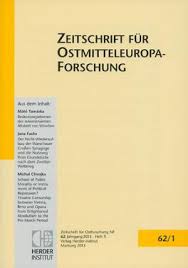Die Innovationsbereitschaft der livländischen Bauern und die Agrarreformen im 19. Jahrhundert
The readiness for innovation of the Livonian peasantry and the agrarian reforms in the 19th century
Author(s): Kersti LustSubject(s): Law, Constitution, Jurisprudence, Agriculture, Social history, 19th Century
Published by: Verlag Herder-Institut
Keywords: Readiness for innovation; Livonian peasantry; agrarian reforms in the 19th century;
Summary/Abstract: The article follows the agrarian transformation on the Livonian stale estates in the nineteenth century according to three important aspects of peasant emancipation: the land consolidation, the transition to money rent, and the emergence of peasant landowners. About one quarter of the peasantry in the Estonian part and approx. 12 per cent in the Latvian part of Livonia lived on slate estates. The author focuses mainly on the state peasants' reaction to the agrarian reforms initiated by the isarist government and to the impact of money economy on agriculture. Did they approve of the changes or were they more inclined to resist them? In the Baltic-German as well as in the latest Estonian historiography, it has been suggested that the Livonian peasantry was rather conservative. The article challenges this widespread assumption. It follows the trend of modern German scholarly literature on agrarian history which shows an increased interest in the role of the peasantry. The land enclosure, the transition to money rent and the purchase of farms did not take place simultaneously in all parts of the gubernia nor did these processes follow always the same pattern. On state estates the rate of money rent and redemption payments were fixed according to the land taxation whilst on private manors the provisions of law allowing for payment of rent in money or for the purchase of farms could be implemented only on the initiative of the manor owners. Peasant lands could be enclosed only with the consent of the manor owner, whereas on state estates decisions about land enclosure, transition to money rent and many other matters were entrusted to the peasants. Therefore, investigation into the development of the agrarian reforms on state estates does reveal more about the attitude and intentions of the Livonian peasantry. It appears that although the state peasants in Livonia cannot be seen as a driving force behind agricultural innovations, there is also very little evidence showing an inherent conservatism of the peasantry or in principle a resistance to innovations. Most peasants, especially in wealthier regions of the gubernia, lacked neither the ability nor the initiative to modernize farming.
Journal: Zeitschrift für Ostmitteleuropa-Forschung
- Issue Year: 55/2006
- Issue No: 4
- Page Range: 510-525
- Page Count: 16
- Language: German

